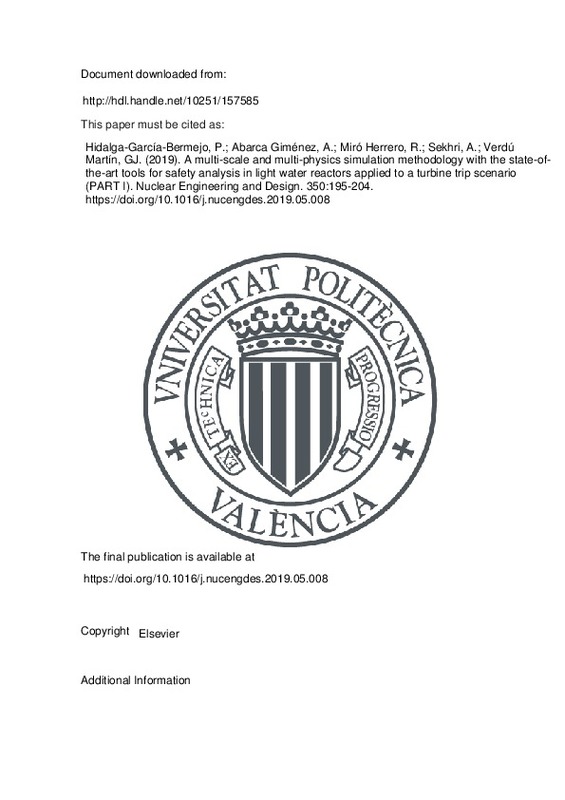JavaScript is disabled for your browser. Some features of this site may not work without it.
Buscar en RiuNet
Listar
Mi cuenta
Estadísticas
Ayuda RiuNet
Admin. UPV
A multi-scale and multi-physics simulation methodology with the state-of-the-art tools for safety analysis in light water reactors applied to a turbine trip scenario (PART I)
Mostrar el registro sencillo del ítem
Ficheros en el ítem
| dc.contributor.author | Hidalga-García-Bermejo, Patricio
|
es_ES |
| dc.contributor.author | Abarca Giménez, Agustín
|
es_ES |
| dc.contributor.author | Miró Herrero, Rafael
|
es_ES |
| dc.contributor.author | SEKHRI, ABDELKRIM
|
es_ES |
| dc.contributor.author | Verdú Martín, Gumersindo Jesús
|
es_ES |
| dc.date.accessioned | 2020-12-22T04:32:52Z | |
| dc.date.available | 2020-12-22T04:32:52Z | |
| dc.date.issued | 2019-08-15 | es_ES |
| dc.identifier.issn | 0029-5493 | es_ES |
| dc.identifier.uri | http://hdl.handle.net/10251/157585 | |
| dc.description.abstract | [EN] The simulation of transient events is a requirement in the evaluation of the safety of Nuclear Power Plants. The Nuclear Authority request the operators to report the prediction of the evolution of the corresponding safety variables using simulation codes and methodologies that have proved to be validated against real data, whether experiments or plant measurements. Moreover, these simulation codes are used in the engineering work that a Nuclear Power Plant needs for planning a competitive and safe operation strategy. The available resources in simulation tools make possible complex analysis that can be used to predict realistic results. The consequence is the opportunity of making a safe and cost-efficient evaluation of the safety margins. Operators can use these tools for licensing to the Nuclear Authority and for calculation support of the operation of the reactor in whichever considered case. This paper presents a methodology that takes advantage of different simulation tools to join the capabilities in the Best Estimate (BE) simulation of transients for Light Water Reactors. This methodology works in different steps to account all the physics using the proper scale in a multi-physics and multi-scale approach. An automatic tool manages the data pre- and post-processing the corresponding input and output files. The purpose is to simulate the transient case in a coarse mesh and generate the boundary conditions for a simulation in more detailed scale with a finer mesh in the next step. Therefore, this methodology works generating the corresponding nodal cross section data to be used in coupled 3D thermal-hydraulics and neutron kinetics simulations run with system codes. A channel-by-channel core model is used in order to identify the critical fuel channel. Finally, the boundary conditions of the critical fuel channel are loaded in a pin-by-pin thermal-hydraulic model to perform the definitive Safety Analysis of the target variable, that is selected by the user. The methodology presented in this paper, is applied to a real fast transient case, a Turbine Trip event of fuel cycle 18 in Kernkraftwerk Leibstadt, KKL. The results of each step of this methodology have been validated against the available plant data and the selected target safety variable, the Critical Power Ratio at pin level, has been code-to-code verified. The results show good agreement proving the effectivity of this methodology. | es_ES |
| dc.description.sponsorship | The authors of this paper acknowledge the interest and economical and technical support of KKL to undertake the development of this project. This acknowledgement is extended to the collaboration of KKL in the research tasks by sharing plant measurements to validate the methodology and to use their software resources to generate useful data for the code-to-code verification. | es_ES |
| dc.language | Inglés | es_ES |
| dc.publisher | Elsevier | es_ES |
| dc.relation.ispartof | Nuclear Engineering and Design | es_ES |
| dc.rights | Reconocimiento - No comercial - Sin obra derivada (by-nc-nd) | es_ES |
| dc.subject | Simulation methodology | es_ES |
| dc.subject | LWR safety analysis | es_ES |
| dc.subject | Turbine trip | es_ES |
| dc.subject | Trace | es_ES |
| dc.subject | Parcs | es_ES |
| dc.subject | Cobra-tf | es_ES |
| dc.subject.classification | INGENIERIA NUCLEAR | es_ES |
| dc.title | A multi-scale and multi-physics simulation methodology with the state-of-the-art tools for safety analysis in light water reactors applied to a turbine trip scenario (PART I) | es_ES |
| dc.type | Artículo | es_ES |
| dc.identifier.doi | 10.1016/j.nucengdes.2019.05.008 | es_ES |
| dc.relation.projectID | info:eu-repo/grantAgreement/MINECO//ENE2012-34585/ES/Desarrollo de una plataforma multifísica de altas prestaciones para simulaciones Termohidráulico-Neutrónicas en ingeniería nuclear/ | es_ES |
| dc.rights.accessRights | Abierto | es_ES |
| dc.contributor.affiliation | Universitat Politècnica de València. Departamento de Ingeniería Química y Nuclear - Departament d'Enginyeria Química i Nuclear | es_ES |
| dc.contributor.affiliation | Universitat Politècnica de València. Escuela Técnica Superior de Ingenieros Industriales - Escola Tècnica Superior d'Enginyers Industrials | es_ES |
| dc.description.bibliographicCitation | Hidalga-García-Bermejo, P.; Abarca Giménez, A.; Miró Herrero, R.; Sekhri, A.; Verdú Martín, GJ. (2019). A multi-scale and multi-physics simulation methodology with the state-of-the-art tools for safety analysis in light water reactors applied to a turbine trip scenario (PART I). Nuclear Engineering and Design. 350:195-204. https://doi.org/10.1016/j.nucengdes.2019.05.008 | es_ES |
| dc.description.accrualMethod | S | es_ES |
| dc.relation.publisherversion | https://doi.org/10.1016/j.nucengdes.2019.05.008 | es_ES |
| dc.description.upvformatpinicio | 195 | es_ES |
| dc.description.upvformatpfin | 204 | es_ES |
| dc.type.version | info:eu-repo/semantics/publishedVersion | es_ES |
| dc.description.volume | 350 | es_ES |
| dc.relation.pasarela | S\408144 | es_ES |
| dc.contributor.funder | Kernkraftwerk Leibstadt AG | es_ES |
| dc.contributor.funder | Ministerio de Economía y Competitividad | es_ES |







![[Cerrado]](/themes/UPV/images/candado.png)

